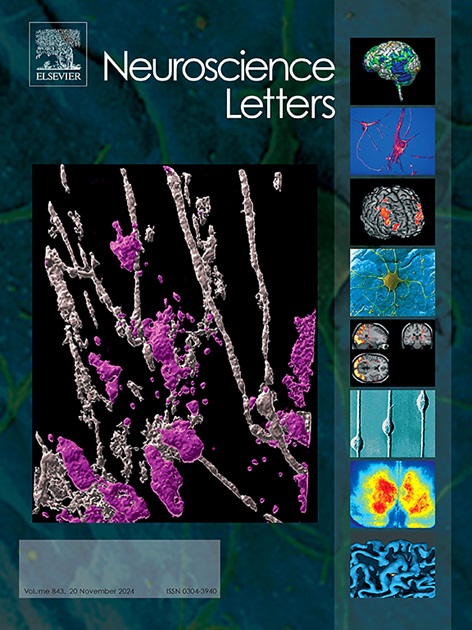Spinal activation of TRPV1-mediated attenuation of a chemoreflex: Potential mechanism of action linking TRPV1 activation with modulation of CaV2.2 channels
IF 2.5
4区 医学
Q3 NEUROSCIENCES
引用次数: 0
Abstract
The objective of the present study was to examine the effect of intrathecal injection of the transient receptor potential vanilloid 1 (TRPV1) channel agonist, capsaicin, on the spinal transmission of the pressure reflex induced by intra-arterial administration of capsaicin (chemoreflex). In decerebrated rats, we found that intrathecal injection of capsaicin attenuated significantly the increase in arterial pressure evoked by intra-arterial capsaicin when compared to intrathecal injection of saline. Afterwards, whole-cell patch-clamp technique was employed to determine if TRPV1 activation was involved in the modulation of voltage-gated Ca2+ channels (CaV2.2) in DiI-labeled sensory neurons innervating the triceps surae muscle. This channel subtype was previously shown to play a key role in the exercise pressor reflex, and is also the major Ca2+ ion carrier in sensory neurons innervating the triceps surae muscle. Our results showed that either TRPV1 agonists, capsaicin or olvanil, inhibited CaV2.2 currents. The agonist-mediated CaV2.2 inhibition was sensitive to the TRPV1 blocker, AMG 517, and absent in sensory neurons isolated from TRPV1 knockout rats. Moreover, in ‘rescue’ experiments, after transfecting sensory neurons from TRPV1 knockout rats with TRPV1 cDNA, application of capsaicin led to CaV2.2 inhibition as observed with neurons isolated from wild-type rats. These data suggest that the decrease of the pressor response following intrathecal capsaicin-mediated stimulation appears to involve a mechanism of action linking TRPV1 activation with CaV2.2 current inhibition.
TRPV1激活介导的化学反射衰减:TRPV1激活与CaV2.2通道调节的潜在作用机制
本研究的目的是研究鞘内注射瞬时受体电位香草样蛋白1 (TRPV1)通道激动剂辣椒素对动脉注射辣椒素(化学反射)诱导的压力反射的脊髓传递的影响。在去脑大鼠中,我们发现,与鞘内注射生理盐水相比,鞘内注射辣椒素显著减轻了动脉内注射辣椒素引起的动脉压升高。随后,采用全细胞膜片钳技术确定TRPV1激活是否参与了支配三头肌表面肌的dii标记感觉神经元的电压门控Ca2+通道(CaV2.2)的调节。该通道亚型在运动压力反射中起关键作用,也是支配肱三头肌表面肌的感觉神经元的主要Ca2+离子载体。我们的研究结果表明,TRPV1激动剂辣椒素或榄香素都能抑制CaV2.2电流。激动剂介导的CaV2.2抑制作用对TRPV1阻滞剂AMG 517敏感,在TRPV1敲除大鼠分离的感觉神经元中不存在。此外,在“拯救”实验中,用TRPV1 cDNA转染TRPV1敲除大鼠的感觉神经元后,应用辣椒素可以抑制野生型大鼠分离的神经元的CaV2.2。这些数据表明,鞘内辣椒素介导的刺激后压力反应的降低似乎涉及TRPV1激活与CaV2.2电流抑制相关的作用机制。
本文章由计算机程序翻译,如有差异,请以英文原文为准。
求助全文
约1分钟内获得全文
求助全文
来源期刊

Neuroscience Letters
医学-神经科学
CiteScore
5.20
自引率
0.00%
发文量
408
审稿时长
50 days
期刊介绍:
Neuroscience Letters is devoted to the rapid publication of short, high-quality papers of interest to the broad community of neuroscientists. Only papers which will make a significant addition to the literature in the field will be published. Papers in all areas of neuroscience - molecular, cellular, developmental, systems, behavioral and cognitive, as well as computational - will be considered for publication. Submission of laboratory investigations that shed light on disease mechanisms is encouraged. Special Issues, edited by Guest Editors to cover new and rapidly-moving areas, will include invited mini-reviews. Occasional mini-reviews in especially timely areas will be considered for publication, without invitation, outside of Special Issues; these un-solicited mini-reviews can be submitted without invitation but must be of very high quality. Clinical studies will also be published if they provide new information about organization or actions of the nervous system, or provide new insights into the neurobiology of disease. NSL does not publish case reports.
 求助内容:
求助内容: 应助结果提醒方式:
应助结果提醒方式:


